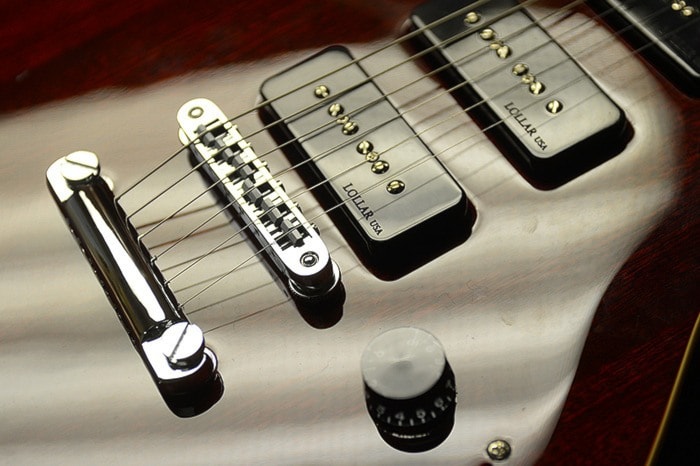There’s something unexpected when Dave Dunwoodie drops one of his guitar picks onto a table.
There is a melodic ting, the sound of a bell, only muffled.
Similarly, ruffling a pile of 500 guitar nuts in a box produces a high-pitched glassy jingle.
Dunwoodie has used the trick before at sales conferences – a way to show off how serious he is about harmonics.
Dunwoodie, a leather-clad guitarist, tinkerer and one-time vacuum cleaner salesman, is the head honcho at Graph Tech Guitar Labs, a manufacturer in Delta’s Tilbury Industrial Park that supplies parts to guitar manufacturers in 35 countries and to distributors in 30 countries.
Among his commercial clients: Gibson, Fender, Taylor, Aria, Peavey, Yamaha and Mahalo (the latter a major ukulele maker). And among his users: Randy Bachman and Sam Roberts.
Graph Tech focuses on saddles, bridge assemblies and nuts made out of materials that make them both slippery (more on that in a bit) and able to maintain tone and vibration transfers when strings are strummed and stretched during playing.
The parts themselves don’t sound sexy in the guitar world, but Dunwoodie has built a legend around the lowly nut (photo) he first patented in the early 1980s.

One day, he was playing a gig in Vancouver with his new Fender Stratocaster. Hitting the tremolo bar (often called a “whammy” bar at the back of the guitar, which, when raised or lowered, changes the tension of the strings), he realized that the binding at the nut (the bar where the strings rest at the neck) made the strings go out of tune afterwards.
In other words, after the tremolo bar was used, the strings wouldn’t properly slide back to their rest positions, putting the guitar out of tune.
The composition of the nut was the problem, he concluded, and set about finding a material that was tough, resonant (musically speaking) and most importantly slippery – something that a conventional bone, wood or plastic nut couldn’t be.
Some guitarists at the time applied graphite from “lead” pencils to the grooves in the nuts, but the graphite didn’t last long and had to be reapplied, with difficulty.
It took some time, but Dunwoodie, spurred by the ’80s’ popularity of the whammy bar and his own frustrations with string binding, eventually developed the first composite-material, self-lubricating nut.
(He recoils a bit if you call it plastic).
But while the composition was slippery – five times that of graphite – it didn’t sell because it was the wrong colour. A white nut was the standard on all guitars, and Dunwoodie’s was black.
It would take years of marketing, reworking formulas (eventually producing optional white nuts), investments in equipment, and more staffing to get Graph Tech into the mainstream.
Photo by Boaz Joseph: Dave Dunwoodie with a few toys in his office in Delta.
 Year after year, Dunwoodie went to trade shows, more or less peddling his goods to manufacturers until they realized what was in front of them. The guitar builders got to know him, and musicians began to take notice too.
Year after year, Dunwoodie went to trade shows, more or less peddling his goods to manufacturers until they realized what was in front of them. The guitar builders got to know him, and musicians began to take notice too.
Over the years, he expanded production to bridges, saddles and related string platforms, and patented designs and company sub-brands such as ResoMax, Ghost, Tusq and Nubone.
“We have a computer that analyzes sound,” he says during a tour of the factory. “So we can play with the materials and see what that does for the sound of an acoustic or electric guitar. Our Tusq material actually increases the harmonics – the ear candy – by 100 per cent.”
He says his String Saver line of saddles that are marketed to do as advertised – put less pressure at critical junctures at the back of a guitar, thus reducing string breakage.
He also sold more than 600,000 of the new aforementioned drop-them-and-they-ting Tusq picks during the first seven months after their introduction.
Most of the parts are manufactured on-site. Graph Tech recently acquired a neighbouring office, doubling their square footage.
“We can switch in and out really quick,” shouts Dunwoodie, standing next to the noisy injection-moulding machine spitting out saddles for Mahalo ukuleles on the factory floor. A run of 400 saddles for one type of guitar may be followed by 20,000 nuts for another.
Staff are at work as early as 5 a.m., assembling, tinkering, testing, packaging, shipping, marketing and designing new projects.
Dunwoodie, who can’t avoid playing riffs on an unplugged electric guitar back in his office, says his staff have a passion for music almost as strong as he does.
“We have good Christmas parties.”
For more information, visit http://graphtech.com
bjoseph@surreyleader.com
